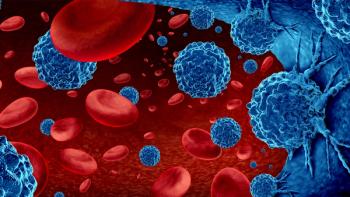
Patients With Advanced Cancer Benefit When Palliative Care Starts Earlier
Patients with advanced cancer who received early specialized palliative care reported better quality of life and satisfaction, according to results from a randomized trial comparing such services with usual care published in The Lancet.
Camilla Zimmermann, MD, PhD, FRCPC
Patients with advanced cancer who received early specialized palliative care reported better quality of life and satisfaction, according to results from a randomized trial comparing such services with usual care published in The Lancet.
The findings demonstrate the benefits of cancer centers that provide early palliative care in outpatient clinics, noted Camilla Zimmermann, MD, PhD, FRCPC, the study’s principal investigator and associate professor and Rose Family Chair in Supportive Care at the University of Toronto in Canada.
“Oncologists should be referring the patient earlier to outpatient palliative care teams to provide collaborative care, because typically palliative care is provided much later in the disease process,” said Zimmermann. “However, a lot of cancer centers and hospitals don’t provide outpatient palliative care teams, so the palliative care team has to make themselves relevant in the outpatient setting.” And even where palliative care is available, she added, “oncologists still tend to refer quite late because of biases and stigmas associated with palliative care.”
Carried out over 4 years at 24 medical oncology clinics under the auspices of the Princess Margaret Cancer Centre, University Health Network, the study enrolled 461 patients (228 intervention, 233 control) with advanced lung, gastrointestinal, genitourinary, breast, or gynecologic cancer. Patients were assessed via completion of questionnaires at baseline and then monthly over 4 months.
The specialized palliative care intervention differed from standard cancer care in several respects. Within 1 month of enrollment, patients receiving the intervention had a 60- to 90- minute consultation with a palliative care physician and nurse to assess symptoms, psychosocial distress, social support, and home services; this was followed by monthly 20— to 50-minute follow-up palliative care consultations. Patients in the intervention group also received telephone calls from a palliative care nurse 1 week after the initial consultation, followed by additional calls as needed. The intervention group had access to a 24-hour telephone service for urgent concerns.
Participants in clinics assigned to the control had no formal intervention. Standard care included treatment by oncologists and oncology nurses rather than a palliative care physician and nurse, with no routine assessment of psychosocial issues or structured assessment of symptoms.
A change in score on the Functional Assessment of Chronic Illness Therapy—Spiritual Well- Being (FACIT-Sp) at 3 months was the study’s primary endpoint. Secondary outcomes included a change in the FACIT-Sp score at 4 months and change scores on other measures, such as the Quality of Life at the End of Life (QUAL-E) and the Edmonton Symptom Assessment System (ESAS), which measures the intensity of nine common symptoms experienced by patients with cancer.
Scores on the FACIT-Sp at 3 months did not differ significantly between the intervention (mean change score +1.60) and the control group (-2.00; P = .07). For the QUAL-E measure, however, a significant difference between the intervention and control was reported at 3 months (+2.33 vs +0.06, respectively; P = .05). FACIT-Sp scores were significantly different for the intervention and control at 4 months (+2.46 vs -3.95, respectively; P = .006). Four-month score differences for intervention versus control were also significant for the QUAL-E (+3.04 vs -0.51, respectively; P = .003) and the ESAS (-1.34 vs +3.23; P = .05).
Zimmermann said that an important outcome of the study is that patients reported improved satisfaction with care. “We found that patients appreciated having a team of professionals available to provide additional support navigating the cancer system and coping with multiple medical and social issues.”
Additional studies are planned to assess the impact of providing early palliative care on the family caregivers of patients with advanced cancers and are under way to assess the model’s economic impact.
Nurse Perspective
Mari Damhof RN, BSN, OCN, ONNNurse NavigatorWillmar Regional Cancer CenterWillmar, MN
Palliative care in the last 20 years has evolved in part because cancer research and treatments have improved and people with cancer are living longer. Cancer is one of the most feared of all illnesses, largely due to the stigma that it means suffering and an early death. This is where palliative care is initiating a change and improving quality of life.
Palliative care, when it was first introduced, became coupled more closely with hospice, which as stated by Camilla Zimmermann, MD, PhD, FRCPC, “gave a view that palliative care is end-of-life measures.” In several studies of palliative care including this one, it is evidence-based that palliative care is most effective when established early on with an illness.
Zimmermann points out that an important outcome of this 4-year study was that patients reported improved satisfaction with the care that they received from the palliative care team. The key words here are improved care and team. Despite the fact that there is not a cure for every individual who is diagnosed with cancer, this doesn’t mean that there isn’t a cure for someone’s suffering, which may be emotional or physical. The palliative care team may include a social worker, a chaplain, a pharmacist, a nutritionist, physicians, nurses, and a physical therapist.
As additional studies are being planned, we will learn more about the barriers to palliative care and also the benefits that palliative care can bring—not only to the patient, but also to the family. Patient care is being brought back to the home with the goal of keeping patients out of care facilities such as hospitals, nursing homes, and swing beds. I anticipate that palliative care will have a significant role in these types of situations.
Newsletter
Knowledge is power. Don’t miss the most recent breakthroughs in cancer care.

















































































